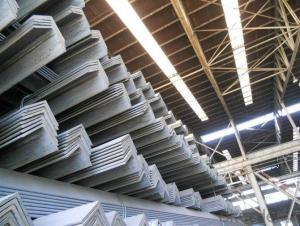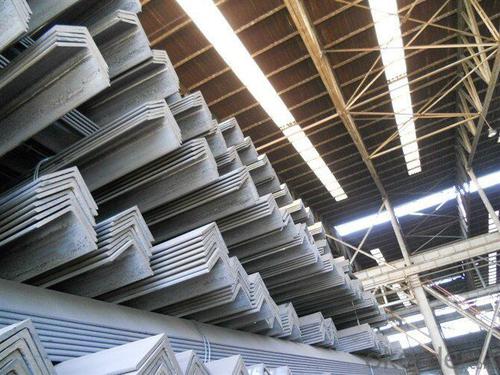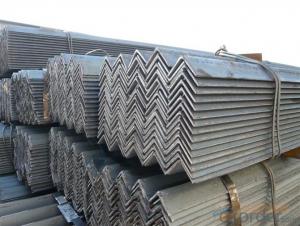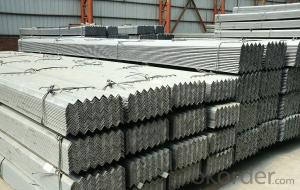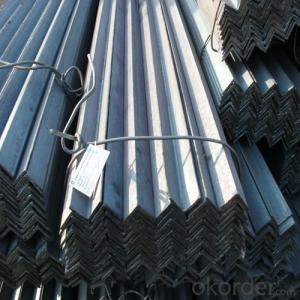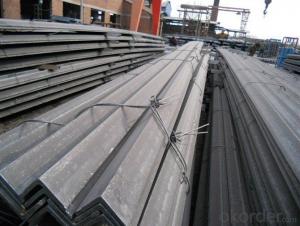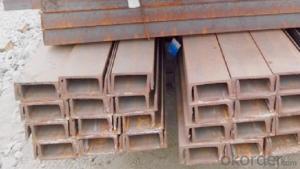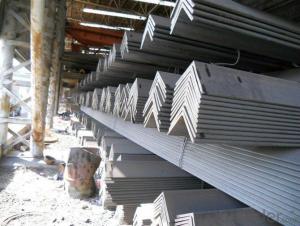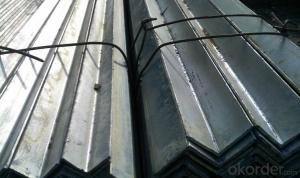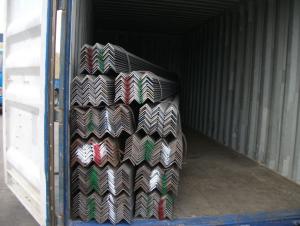2015 Hot Rolled Angle Steel in JIS Standard
- Loading Port:
- Tianjin
- Payment Terms:
- TT OR LC
- Min Order Qty:
- 25 m.t.
- Supply Capability:
- 20000 m.t./month
OKorder Service Pledge
OKorder Financial Service
You Might Also Like
Specification
OKorder is offering high quality Hot Rolled Steel Angle at great prices with worldwide shipping. Our supplier is a world-class manufacturer of steel, with our products utilized the world over. OKorder annually supplies products to European, North American and Asian markets. We provide quotations within 24 hours of receiving an inquiry and guarantee competitive prices.
Product Applications:
Hot Rolled Steel Angles are ideal for structural applications and are widely used in the construction of buildings and bridges, and the manufacturing, petrochemical, and transportation industries.
Product Advantages:
OKorder's Steel Angles are durable, strong, and resist corrosion.
Main Product Features:
· Premium quality
· Prompt delivery & seaworthy packing (30 days after receiving deposit)
· Corrosion resistance
· Can be recycled and reused
· Mill test certification
· Professional Service
· Competitive pricing
Product Specifications:
Manufacture: Hot rolled
Grade: Q195 – 235
Certificates: ISO, SGS, BV, CIQ
Length: 6m – 12m, as per customer request
Packaging: Export packing, nude packing, bundled
Sizes: 25mm-250mm | ||
a*t | ||
25*2.5-4.0 | 70*6.0-9.0 | 130*9.0-15 |
30*2.5-6.6 | 75*6.0-9.0 | 140*10-14 |
36*3.0-5.0 | 80*5.0-10 | 150*10-20 |
38*2.3-6.0 | 90*7.0-10 | 160*10-16 |
40*3.0-5.0 | 100*6.0-12 | 175*12-15 |
45*4.0-6.0 | 110*8.0-10 | 180*12-18 |
50*4.0-6.0 | 120*6.0-15 | 200*14-25 |
60*4.0-8.0 | 125*8.0-14 | 250*25 |
FAQ:
Q1: Why buy Materials & Equipment from OKorder.com?
A1: All products offered byOKorder.com are carefully selected from China's most reliable manufacturing enterprises. Through its ISO certifications, OKorder.com adheres to the highest standards and a commitment to supply chain safety and customer satisfaction.
Q2: How do we guarantee the quality of our products?
A2: We have established an advanced quality management system which conducts strict quality tests at every step, from raw materials to the final product. At the same time, we provide extensive follow-up service assurances as required.
Q3: How soon can we receive the product after purchase?
A3: Within three days of placing an order, we will begin production. The specific shipping date is dependent upon international and government factors, but is typically 7 to 10 workdays.
Alloy No | Grade | Element (%) | ||||
C | Mn | S | P | Si | ||
Q235 | B | 0.12—0.20 | 0.3—0.7 | ≤0.045 | ≤0.045 | ≤0.3 |
Alloy No | Grade | Yielding strength point( Mpa) | ||||
Thickness (mm) | ||||||
≤16 | >16--40 | >40--60 | >60--100 | |||
≥ | ||||||
Q235 | B | 235 | 225 | 215 | 205 | |
Alloy No | Grade | Tensile strength (Mpa) | Elongation after fracture (%) | |||
Thickness (mm) | ||||||
≤16 | >16--40 | >40--60 | >60--100 | |||
≥ | ||||||
Q235 | B | 375--500 | 26 | 25 | 24 | 23 |
Images:
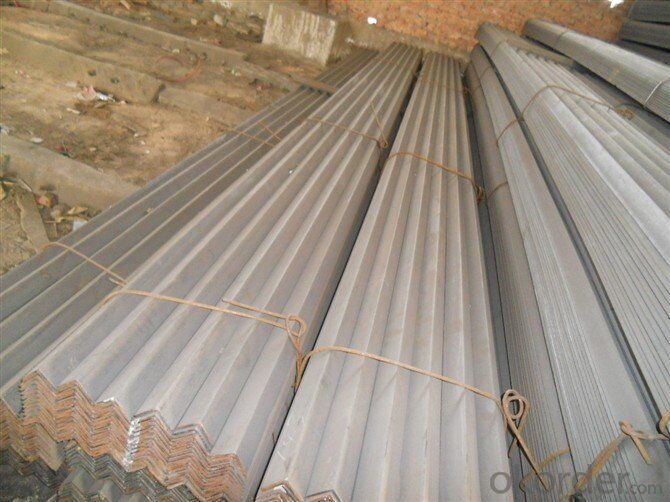
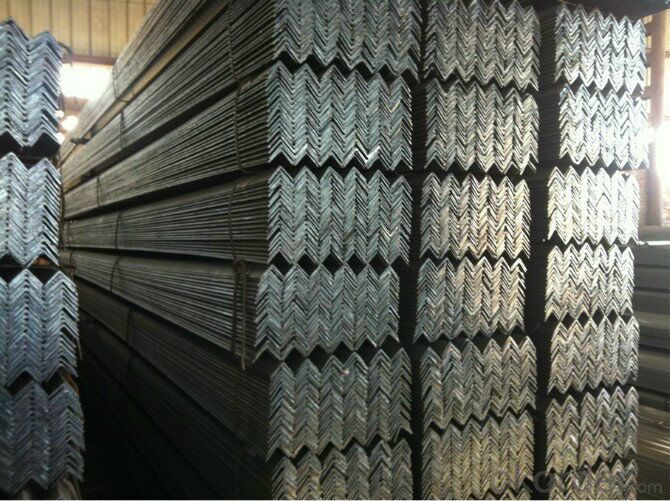
- Q: Can steel angles be used in electrical applications?
- Yes, steel angles can be used in electrical applications. They are often used as structural supports or brackets for mounting electrical components, conduit, or cable tray systems. Steel angles provide strength and stability, making them suitable for various electrical applications in both residential and commercial settings.
- Q: How do you calculate the moment of inertia for a steel angle?
- In order to determine the moment of inertia of a steel angle, it is necessary to have knowledge of the angle's dimensions and shape. The moment of inertia measures an object's resistance to rotational changes and is influenced by the distribution of mass and the distance between the object's mass and the axis of rotation. For a steel angle, the moment of inertia can be computed using the parallel axis theorem, which states that the moment of inertia around an axis parallel to the original axis is equal to the sum of the moment of inertia around the original axis and the product of the mass and the square of the distance between the two axes. To calculate the moment of inertia for a steel angle, the following steps can be followed: 1. Obtain the measurements of the steel angle, including its length, width, and thickness. 2. Determine the angle's area by multiplying the length by the thickness. 3. Identify the centroid of the angle, which is the point where the mass is evenly distributed. For a symmetrical angle, the centroid is located at the intersection of the two legs. For an asymmetrical angle, the centroid can be determined by utilizing the geometric properties of the shape. 4. Compute the moment of inertia around the centroid axis using the formula for a rectangle: I = (1/12) * width * thickness^3. This calculation assumes that the angle is a thin-walled section. 5. Calculate the distance between the centroid axis and the axis for which the moment of inertia is desired. This can be accomplished by measuring the perpendicular distance between the two axes. 6. Apply the parallel axis theorem to determine the moment of inertia around the desired axis. The formula is: I_total = I_centroid + mass * distance^2. By following these steps, it is possible to calculate the moment of inertia for a steel angle. However, it should be noted that these calculations are based on a simplified model of the angle and may not provide accurate results for complex or irregular shapes.
- Q: How do steel angles compare to wooden beams?
- Steel angles and wooden beams possess distinct characteristics and abilities that render them suitable for diverse applications. Steel angles, being comprised of steel, demonstrate exceptional strength and longevity. They exhibit remarkable tensile strength and resist bending and warping even when subjected to substantial loads. This renders them an excellent choice for providing structural support in constructions such as buildings, bridges, and other similar projects. Moreover, steel angles possess the advantage of being non-combustible, thereby enhancing fire safety. Conversely, wooden beams offer their own set of advantages. As a natural material, wood is readily accessible and renewable, making it a more environmentally conscious option when compared to steel. Additionally, wooden beams possess an inherent aesthetic appeal, particularly in traditional or rustic designs. They can be effortlessly customized and shaped, enabling the creation of intricate and imaginative designs. Nevertheless, wooden beams do have certain limitations with regards to strength and durability. They do not exhibit the same level of robustness as steel angles and are susceptible to bending, warping, and rotting over time. Additionally, wood is combustible, which can pose safety concerns. In conclusion, both steel angles and wooden beams possess their own unique strengths and weaknesses. Steel angles excel in projects necessitating high strength and durability, while wooden beams offer a more natural and visually appealing option. Ultimately, the choice between the two depends on specific project requirements, budgetary considerations, and personal preferences.
- Q: Can steel angles be used in the construction of government buildings?
- Government buildings can indeed utilize steel angles for construction purposes. The strength and durability of steel angles make them a prevalent choice in building construction. Their ability to provide stability and support to the overall structure deems them appropriate for government buildings, which require sturdy and long-lasting construction materials. Furthermore, the versatility of steel angles allows for easy fabrication and customization, meeting the specific design requirements of various architectural and structural applications within government buildings.
- Q: Can steel angles be used for decorative purposes?
- Yes, steel angles can definitely be used for decorative purposes. They can be shaped and designed in various ways to add a modern and industrial touch to interior or exterior spaces. Steel angles can be used as decorative accents, such as in furniture design, architectural details, or even as standalone decorative pieces. Their durability and versatility make them an excellent choice for adding a unique and stylish element to any space.
- Q: Can steel angles be used in automotive chassis construction?
- Yes, steel angles can be used in automotive chassis construction. Steel angles, also known as angle irons, are commonly used in the construction industry for their strength and versatility. In automotive chassis construction, steel angles can be used to provide structural support and reinforcement to the chassis frame. Steel angles are often used to create the frame structure of a vehicle's chassis, providing a stable and rigid framework. They can be used to form the main longitudinal and cross members, as well as other structural components. The use of steel angles in automotive chassis construction offers several advantages. Firstly, steel is a strong and durable material, making it suitable for withstanding the various stresses and loads experienced by the chassis. Steel angles can also be easily fabricated and welded, allowing for flexibility in design and customization. Moreover, steel angles are cost-effective compared to other materials such as aluminum or carbon fiber. This makes them a popular choice in automotive chassis construction, especially for mass-produced vehicles where cost efficiency is crucial. However, it is important to consider the specific requirements and regulations of the automotive industry when using steel angles in chassis construction. Chassis design must meet certain safety standards, including crashworthiness and structural integrity. Therefore, it is essential to ensure that the chosen steel angles and their dimensions are appropriate for the intended application and comply with relevant regulations. In conclusion, steel angles can indeed be used in automotive chassis construction. Their strength, versatility, cost-effectiveness, and ease of fabrication make them a suitable choice for creating the frame structure of a vehicle's chassis. However, it is important to consider safety regulations and ensure that the chosen steel angles meet the required standards.
- Q: Can steel angles be used for HVAC ductwork?
- Indeed, HVAC ductwork can utilize steel angles. In the construction field, steel angles are frequently employed for diverse purposes, such as acting as supports and reinforcements. In terms of HVAC ductwork, steel angles can serve as a framework, ensuring stability and bolstering the ducts. Through welding or bolting, they can be joined together to create a robust and enduring structure for the ductwork system. Moreover, steel angles can be easily tailored and cut to specific lengths, making them suitable for various configurations of ductwork. Nevertheless, it is crucial to bear in mind that appropriate insulation and lining might be necessary for steel angles to prevent condensation and maintain the desired temperature within the ducts.
- Q: How do you clean and maintain steel angles?
- To clean and maintain steel angles, start by removing any surface dirt or debris using a soft cloth or brush. Then, prepare a mixture of mild soap and warm water and use it to wipe down the angles thoroughly. Rinse the angles with clean water and dry them completely to prevent rust formation. It's advisable to apply a light coat of oil or a rust inhibitor to protect the steel angles from corrosion. Regular inspections and prompt removal of any accumulated dirt or moisture will help maintain the steel angles' quality and prolong their lifespan.
- Q: Are there any environmental benefits of using steel angles?
- Yes, there are several environmental benefits of using steel angles. Firstly, steel is one of the most recycled materials in the world. When steel angles are no longer needed, they can be easily recycled into new steel products, reducing the demand for new steel production. This recycling process requires less energy and resources compared to producing steel from raw materials, resulting in significant energy savings and reduced carbon emissions. Additionally, steel is a durable material that has a long lifespan. This means that steel angles require less frequent replacement compared to other materials, reducing the amount of waste generated. The durability of steel also means that it requires less maintenance and repairs over time, further reducing its environmental impact. Furthermore, steel is resistant to fire, pests, and rot, reducing the need for chemical treatments and preservatives that can be harmful to the environment. Steel angles also have high strength-to-weight ratio, meaning that less material is required to achieve the same structural integrity compared to other materials. This not only reduces the amount of raw materials needed but also decreases transportation costs and fuel consumption during construction. Lastly, steel is highly versatile and can be used in a wide range of applications, from construction to manufacturing. This versatility allows for the creation of innovative and sustainable designs that optimize energy efficiency and reduce environmental impact. For example, steel angles can be used in the construction of energy-efficient buildings that incorporate renewable energy systems, reducing overall energy consumption and greenhouse gas emissions. Overall, the use of steel angles offers several environmental benefits, including reduced energy consumption, lower carbon emissions, decreased waste generation, and increased durability. These factors make steel angles a sustainable and environmentally-friendly choice for various applications.
- Q: Can steel angles be used in construction?
- Indeed, construction can utilize steel angles. Due to their versatility, strength, and cost-effectiveness, steel angles are frequently employed as structural elements in construction endeavors. Their primary purpose is to support and reinforce various structural components, including beams, columns, and walls. Various sizes and thicknesses of steel angles are available, allowing for a wide range of applications in construction. They can be easily joined together through welding, bolting, or fastening, facilitating convenient on-site installation and customization. A key advantage of incorporating steel angles in construction lies in their high strength-to-weight ratio. This attribute enables steel angles to possess outstanding load-bearing capacity while remaining relatively lightweight, rendering them highly suitable for structures that necessitate strength without excessive weight. Moreover, steel angles exhibit excellent durability and resistance against environmental factors such as corrosion, fire, and pests. Consequently, structures constructed with steel angles boast extended lifespans and require minimal maintenance over time. In summary, steel angles offer a versatile and dependable option for construction projects, regardless of whether they are residential, commercial, or industrial in nature. Architects, engineers, and contractors commonly favor steel angles due to their strength, durability, and ease of installation.
Send your message to us
2015 Hot Rolled Angle Steel in JIS Standard
- Loading Port:
- Tianjin
- Payment Terms:
- TT OR LC
- Min Order Qty:
- 25 m.t.
- Supply Capability:
- 20000 m.t./month
OKorder Service Pledge
OKorder Financial Service
Similar products
Hot products
Hot Searches
Related keywords
